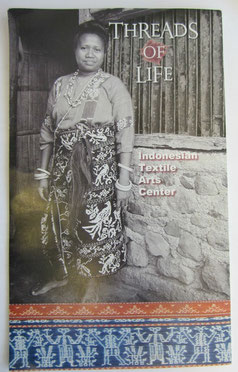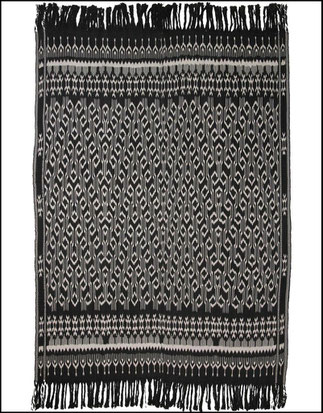Textiil - News, Notes, Events & Adventures
There's always something new to see and learn about Southeast Asian culture and textiles. Historical information, the creative process, types of textiles and motifs, global artisans and designers at work -- plus news and events from organizations, museums and galleries, books, articles, and personal travel experiences. Enjoy! And if you have a recommendation for a post, please send me a message.
Hundreds of Years New

Last fall, there was a lively batik expo in central Java. A celebration of the textile’s heritage, it’s current state, and its future opportunities. Booths brimmed with cloth in endless variations. Intricate tulis batiks (hand drawn) appeared next to displays of bold, modern block prints. Vibrantly colored textiles were stacked near cloths of nuanced hues made with natural dyes. And everywhere there were patterns—some contemporary, some traditional, often eye-popping and original.
Makers, with their family and friends showed up -- from the Jogjakarta region to the northern coast. Elegant fashion shows drew crowds—and no wonder! It was a great affair. Artisans witnessed their work exhibited alongside private collections of antique textiles from Madura, Cirebon, and Pekalongan. The event was a vibrant, positive
show of support for the region’s batik industry.

Walking from display to display, I wondered: Which pieces would these batik-artists consider the most special? Though I’m not a forward person, the culture is a warm and welcoming one, so I chose a few of my favorite displays and asked the question. And each person’s thoughtful selection generally highlighted innovation and skill within the craft. Their choices deepened my appreciation for the integrity of the line-work, the complexity of motifs, and the expressive combinations of patterns and techniques.
In batik, a block print motif often looks simple. But, this is deceptive. Artfully done, these patterns are born of a time-consuming, multi-step process that requires exquisite attention to detail. At Textiil, our goods – pillows and table linens – honor this. The cloth is made in small batches as we work to find new motifs and colors that will maintain the heritage process and creative integrity, but also resonate in the western marketplace. And we do produce multiples in order to bring to market a selections of goods more affordable than the incredibly detailed one-of-a-kind tulis batiks. What results are crisp, fresh designs with gentle variance.

And it’s this, the variance, that makes the batiks so compelling. The tropical rains don’t always cooperate with production deadlines, and neither do family celebrations, cultural days off, or the sudden need for a new, hand-hewn tool. Always a challenge, but also a reminder: Look for the small inconsistencies in the cloth. In them, glimpse the real-life circumstances in which our batiks are made. We trust that fans of our products see this and are intrigued by this evidence of the human hand. Because the variance, that uncertainty found in the close look, is also what makes the batiks so rich with possibility.
Simplicity

Every three years the William Penn Charter School, a Friends school, hosts an exhibition showcasing artists and craftspeople within a radius of Philadelphia. For some of us with only passing experience with Quaker values: They encompass a set of testimonials or principles. Key among them are peace, integrity, equality, simplicity, community, and care for the earth.
As a recent transplant to the Philadelphia area, I was delighted to be invited to submit a few of Textiil’s batiks along with a statement linking the textiles to the theme of “Simplicity.” So I chose two natural dye block batik tablecloths to display and offered this explanation:
Pared down to the essentials, traditional wax resist batik is made by hand using copper tjaps dipped in wax to create pattern on cloth. The cloth is submerged in dye to take on color. Then the wax is boiled out and both the color and pattern are fixed.
There is simplicity in the transparent relationship to, and respect for, the natural world -- through pattern, materials and processes -- as reflected in these cloths. At the same time, there is a liveliness in the relationship between the surface expression of simplicity, and what lies just beneath. To start, I like that a single block print seems simple, but many together decorative.
The block, or tjap is made of copper and is held by hand, dipped in wax, and used for years in countless repetitions, informing cloth with pattern. The cloth is made of cotton. It retains the ghost smell of wax through a few washings and then disappears. The dye is made by fermenting leaves, or boiling out color from parts of plants and trees. These materials are familiar to us. And there is clarity, not complication, in the process: No machines, no chemicals – but still interactions and reactions. Also invisible is a deep understanding of the process: Proper proportions, temperatures, timing; a trained hand and a trained eye. All of these are necessary.
I like that the work looks consistent, but on closer inspection something will reveal itself – in the dye, or pattern, or fabric – and it will be certain that this cloth is truly made by hand.
*****************************************************
And now the two textiles, designed here and crafted in Jogjakarta, Indonesia are SOLD. It's ime for someone new to enjoy them in their own way. In addition to the artist who now owns these batiks, many more people took the time to say how happy they were to see them at the entrance to the show, and how beautiful they looked.
And I will tell my partner in Indonesia about this art exhibition with the theme of Simplicity -- as best I am able. And in a strange reversal, I see what a perfect fit these batiks were for a show theme based on a principle from a value system seemingly so different on the surface, but fundamentally very similar to his own. And I hope he will join me for just a moment to consider our work together -- the complexity and the simplicity; the interactions and the reactions. And to appreciate the many people who shared in the simple pleasure of seeing our cloth.
Indonesia Travels - Threads of Life

Already March and the snow just keeps coming! It’s a great day to warm up with a highlight from our visit to Indonesia in January/ February. Even when it was blisteringly hot there, we were so happy to be missing a little bit of this super long northeast winter.
After our work in Java was complete, this was to be my first visit to Bali. So I set my sights on seeing the ikat weaving in Gianyar and visiting the special Threads of Life Textile Arts Center and Gallery in Ubud.
Threads of Life Textile Arts Center and Gallery is a reasonably pleasant walk down Jalan Kajeng off the very busy main street Jalan Raya Ubud in the center of town. In their own words: “Threads of Life is a fair trade business that uses culture and conservation to alleviate poverty in rural Indonesia. The heirloom-quality textiles and baskets we commission are made with local materials and natural dyes. With the proceeds from the Threads of Life, we help weavers to form independent cooperatives and to manage their resources sustainably.”
The organization was established in 1998 and they now work with over one thousand weavers in eighty communities. The gallery in Ubud is a nicely designed, modestly sized space with textiles, and smaller items including pillows and scarves upstairs. Information on materials, including natural plant dyes and processes, and classes and special exhibits is also interspersed throughout.

On the well-lit lower level there are more of the bigger woven pieces with photos and
information about the weavers and their cultures aside each piece. Everything is well presented. The atmosphere is so relaxed that it’s easy to forget how rare it is to see such a
unique selection of (mostly) woven textiles from across the islands. (There were also a few modern batik pieces from an artist in Solo which I enjoyed). The staff is happy to tell
more about the organization or any of the individual pieces.
Many of the textiles are likely to be hung as art for display. To that end, we were lucky to participate in the lively discussion with a friendly Australian shopper was choosing between two beautiful black and white weavings for the wall above her bed. They were similar to the piece pictured above from ThreadsofLife.com. And even more stunning in person!
For those not heading to Bali soon, visit Threads of Life online
For more information about the mission and ongoing work of the organization, see
this inspiring TEDx Ubud video --> Threads of Life
Co-Founder William Ingram: Weaving a new approach to poverty alleviation
Outdoors: Once you are back at Jalan Raya Ubud with Threads of Life behind
you, consider taking a break from the bustling shopping in the center of town. Turn right and walk about 15 minutes until you find the Campuhan Ridge Trail – the entrance is just before the Clinic. If you reach the bridge you have gone
too far. The ridge hike is glorious! And a well deserved respite from the Ubud shopping
crowds.
